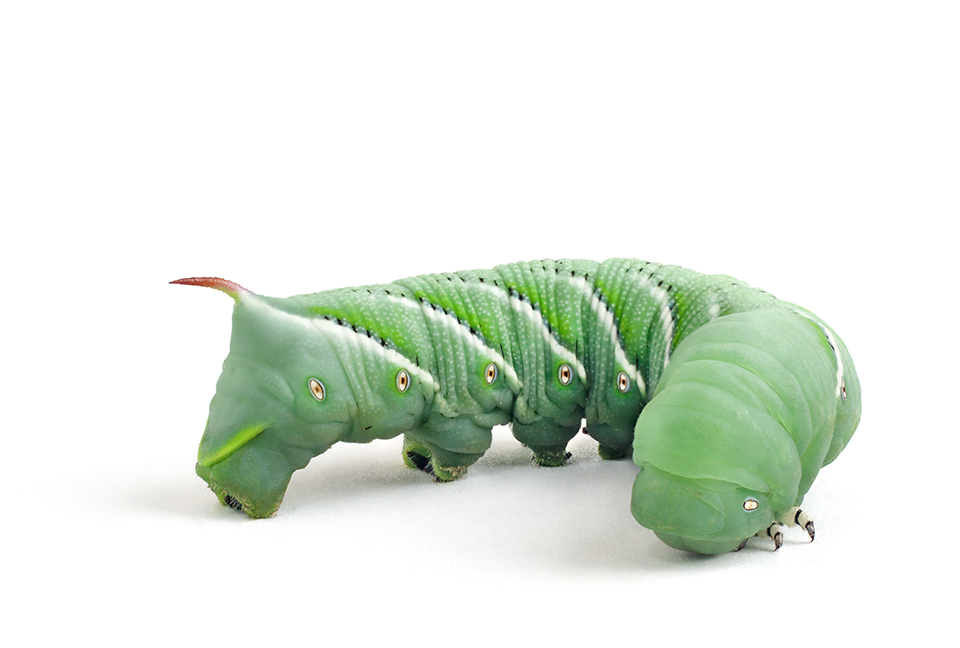Q. Last year, I had more Tomato Hornworms than I’ve ever experienced in the past. I’ve been picking them off but is there another method of controlling them? Also, what, if anything, do they develop into?

A. The Tomato Hornworm is the larval stage of the Spink or Hummingbird moth. Their life cycle or metamorphosis has four stages. It begins with the adult female moth laying round, pale green, eggs on the leaves of the tomato. The eggs hatch into small, green, caterpillars with a structure or horn on its backside. In stage two. The worms grow very large, up to four inches long and have only one purpose and that is to eat, twenty-four/seven. Hence in a short period, they do lots of damage. They feed all summer long before they go into the pupa or third stage of their metamorphosis. In September, the pupa drops to the ground and pupae as a hard, brown shell, structure. This structure has a narrow tongue that sticks out, like the handle on a pitcher, so it’s easy to identify. While they are in the ground, they develop into the adult moth or fourth stage of their life cycle. In late May or early June, they emerge from the ground to start the cycle all over again. Besides hand picking them off the plants, there are several other environmentally friendly Hornworm controls. Because of the previous years’ problem, I first apply beneficial Nematodes to the soil to control the pupae now. This treatment isn’t always necessary. Beneficial Nematodes are tiny, worm-like critters that hunt, seek, and destroy soil pests including the Tomato Hornworm pupae and grubs but not earthworms. They are available at your favorite garden center along with the other beneficial insects like Ladybugs and Praying Mantis. The worms should start to appear in late June or early July, so be on the lookout for them. Early on, they are found toward the center of the plant. They’re located on the undersides of the leaves and are relatively small; I’d be looking for any leaves that have been chewed or have large holes and or black dropping around the base of the plants. Captain Jack Dead Bug Brew or Bacillus Thuringiensis, also known as BT, are two environmentally friendly pesticides that control the worms. You must make repeat applications about every three weeks as you can have multiple infestations during the Hornworm season. The adult moth will fly in from surrounding yards. BT is specific to worms and gives them a lethal case of stomach flu. The worms continue to feed for a while before they are stricken, so the damage continues. It’s suggested when you can wait several days for the control to start to work. Captain Jack Dead Bug Brew is a broader pesticide. It will kill on contact as well as by ingestion. It is the preferred choice if you need an immediate control. I’d suggest you remove the worms until the population grows and then spray with Captain Jack Dead Bug Brew.
Q. The yellow flowering Oxalis is a problem with my lawn this time of the year. My attempts at pulling/digging out the main roots seem only to have resulted in spreading more seeds. What should I use to get rid of it?
A. Oxalis is a pesky weed to control in turf. Unfortunately, manually removing Oxalis proves to be tedious and unsuccessful as it reproduces itself from seeds as well as underground rhizomes. There are many broadleaf herbicides available to control Oxalis. I’ve found that Turflon Ester from Monterey Lawn and Garden does the best job in controlling the Oxalis. It’s a liquid that’s applied with a tank sprayer. One application generally is sufficient to control the actively growing Oxalis, but a repeat application is necessary to kill off the newly germinated seedlings. This is a war of attrition that you win.
Q. Is it okay to recycle old wine in the garden? We want to discard some old bottles. So far, we have hesitated for fear that it might not be a good thing.
A. With old wine, I’d pour it down the drain and not on your compost pile or around plants. Like a wine barrel, the pungent fragrance of the wine could last for an extended period. My horticultural concern is what if the wine has turned to vinegar. The increased acidity could be damaging. Hence, I see very little value in disposing of it in a garden.
Leave a Reply